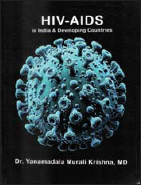Translate this page into:
Book Review: HIV-AIDS in India and Developing Countries
[To cite: Soneja M. HIV-AIDS in India and developing countries (Book Review). Natl Med J India 2024;37:222. DOI: 10.25259/NMJI_991_2024]

HIV-AIDS in India and Developing Countries. Yanamadala Murali Krishna. Anupama Printers, Hyderabad. 122pp, ₹155. ISBN 978–819691507–0.
This book is a captivating and informative exploration of the HIV/AIDS pandemic, designed for the general public, PLHIV (people living with HIV) and non-expert healthcare workers. Through its storytelling approach, the book makes the subject of HIV/AIDS accessible and engaging for a broad audience. It traces the origin of the virus, details its impact, and provides insights into the specific challenges faced in resource-limited settings such as India. With a storytelling approach, the book aims to raise awareness and demystify the complexities of HIV/AIDS using simple language and personal experiences.
One of the most engaging aspects of the book is how it traces the origin and evolution of HIV/AIDS. Starting from the early days when the virus was first identified, the narrative takes the readers through the initial confusion and fear that surrounded the disease. The author vividly describes how the virus spread globally, emphasizing the major milestones in understanding its transmission and pathology. This historical context is crucial for readers to appreciate the progress made in the fight against HIV/AIDS.
The book excels in using simple language to explain complex medical concepts, making it accessible to readers with no prior knowledge of the topic. The primary aim of the book is to raise awareness about HIV/AIDS. It addresses common misconceptions and stigma associated with the disease, emphasizing the importance of education and compassion. The author shares his own experiences and opinions throughout the book, providing a unique and personal perspective on the issue. This approach adds authenticity and depth to the narrative, though it also introduces opinions that many experts may not agree with. By including diverse viewpoints, the book encourages the readers to think critically and engage in discussions about HIV/AIDS.
A considerable portion of the book is dedicated to the challenges faced in resource-limited settings such as India. It highlights the unique obstacles in diagnosing, treating and managing HIV/AIDS in such environments. The author also presents potential solutions to these problems, advocating for community-based approaches, increased funding and research. These solutions are presented realistically, acknowledging the complexities and limitations of healthcare systems in resource-limited settings.
Despite covering a broad range of topics, the book is concise and to the point. It avoids overwhelming the readers with excessive technical details, focusing instead on the essential information needed to understand HIV/AIDS. This conciseness makes the book a practical guide for non-expert healthcare workers and the general public, providing them with the knowledge to contribute to the fight against the pandemic.
The book is priced reasonably, making it accessible to a wide audience. The book is well-organized, with each chapter seamlessly flowing into the next. The chapters are structured to gradually build the reader’s knowledge, starting from basic concepts and progressing to more detailed discussions. This organization ensures that readers are not overwhelmed and can easily follow the narrative. The illustrations in the book are clear and enhance the reader’s understanding of the content. Diagrams explaining the structure of the virus, transmission routes, and the stages in HIV replication are particularly useful. The clear and logical progression of ideas makes the book a useful resource for anyone looking to gain understanding of HIV/AIDS.




